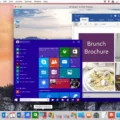Do you have a Mac and suddenly your browser is hijacked by Yahoo? Have you been trying to figure out a way to get rid of the Yahoo redirect virus on your computer? We understand how frustrating this can be, so we’ve put together this blog post to help you get rid of the Yahoo redirect virus on your Mac.
The Yahoo redirect virus is a type of malware that can infect your web browser and redirects it to the Yahoo search page. This virus is usually spread through malicious websites, adware, and other forms of malicious software. Once it has infected your computer, it will cause your browser to continuously redirect you to the Yahoo search page whenever you try to access a website or search for something online.
Fortunately, there are steps you can take in order to eliminate the Yahoo redirect virus from your Mac. The first step is to change your default search engine from Yahoo back to one of the more reputable ones such as Google or Bing. To do this, open up Safari and click on Preferences followed by Advanced. In the Advanced Settings menu, make sure that the “Show Develop menu in the menu bar” option is enabled before scrolling down and checking “Change Search Engine” at the bottom of the list.
The second step is removing any unwanted extensions from Safari that could be related to the Yahoo redirect virus. To do this, simply open Safari and click on Preferences followed by the Extensions tab. Here, look for any suspicious extensions that look unfamiliar or have strange names and click Uninstall next to them in order to delete them from Firefox permanently.
The third step is restoring all of your browser settings back to its original defaults. To do this, open up Safari again and select Preferences followed by the General tab at the top left-hand corner of the window. From here, click Restore Defaults located at the bottom right-hand corner of the window before clicking OK in order to confirm your selection and save changes made so far.
The fourth step is uninstalling any unrecognized programs that could be related to Yahoo Redirect Virus from your Mac. To do this, open the Finder window followed by the Applications folder where all installed programs are stored in the macOS operating system by default before locating any unknown or suspicious programs that might be related to Yahoo Redirect Virus infection before dragging them into the Trash folder located on Dock bar at bottom right-hand corner of desktop screen where all removed files are stored temporarily until emptied manually later (or just select program icons then press Command + Delete keys simultaneously).
The fifth step is removing all temporary files stored on the hard drives which could be related to Yahoo Redirect Virus infection as well as using CleanMyMac X application designed specifically for cleaning up hard disks from viruses like these (please note that this application requires a separate purchase). Once installed, launch CleanMyMac X then select the System Junk option followed by the Scan button located at the bottom left-hand corner of the main CleanMyMac X window before selecting the Clean button located at the bottom right-hand corner after the scan finishes in order to remove all temporary files associated with yahoo Redirect Virus infection including its own components scattered around macOS file system.
The sixth step involves running an antivirus scan using the Avast Free Mac Security application (or any other antivirus program available online) in order to detect any remaining malicious files associated with Yahoo Redirect Virus infection before deleting them automatically once detected (please note that some malicious components may remain hidden inside system folders so thorough scanning procedure must be applied here). Once finished successfully without any errors reported during the scan process, reboot the computer normally afterward for changes made during the removal process to take effect properly afterward (please note that some additional manual steps such as deleting remaining registry entries associated with Yahoo Redirect Virus may also be required here).
Finally, if none of these steps worked for you or if the problem persists even after completing these steps then please contact the professional technical support team immediately in order to find out what else should do here in order to resolve the issue properly without risking further damage being done other parts macOS operating system which could result in complete reinstallation entire operating system itself afterward!

Removing the Yahoo Redirect Virus from a Mac
To get rid of Yahoo redirect virus on Mac, start by opening the web browser and going to the Safari menu. On the Preferences screen, click on the Advanced tab and enable the option saying “Show Develop menu in menu bar”. After that, expand the Develop entry in the Safari menu and click on Empty Caches.
Next, open Finder and select Go to Folder from the Go menu. Then type ~/Library/Preferences/ into the dialog box that appears and hit Enter. Find com.apple.Safari.plist file and delete it (you may need to provide your administrator password).
Then go back to the browser and select History > Show All History from the Safari menu bar. At this point, select Clear History from the bottom of the drop-down list which should effectively clear all traces of the Yahoo redirect virus from your Mac. Finally, restart your computer for changes to take effect.
Stopping Yahoo from Hijacking My Browser
To stop Yahoo from hijacking your browser, you’ll need to take the following steps:
1. Change your default search engine. Go to your browser’s settings and change the default search engine from Yahoo to something else.
2. Remove any unwanted extensions or add-ons from your browser. If you have any extensions or add-ons installed that were not authorized by you, it is best to remove them immediately.
3. Restore your browser’s default settings. This will ensure that all of the settings are back to their original state and are not affected by any changes made by Yahoo or other unknown sources.
4. Uninstall unrecognized programs from your computer and browser. If you have installed any programs that seem suspicious or are from an unknown source, it is best to delete them immediately as they may be responsible for hijacking your browser in the first place.
5. Remove temporary files and cookies from your computer regularly using a reliable program such as CCleaner or a similar tool that can detect and remove these files safely without damaging anything else on your system.
6. Finally, install an antivirus program on your computer and scan it regularly so that any malicious software present on the device can be eliminated before it causes further damage to your system or personal data stored within it.
Why is My Mac Using Yahoo?
Your Mac may be using Yahoo if it has been infected with a browser hijacker virus. Browser hijacker viruses are malicious programs that hackers use to redirect your web searches to Yahoo, earning them revenue generated by clicks on Yahoo. To get rid of the Yahoo virus, you can reset your browser settings for Chrome, Safari, or Firefox. Another way to prevent this from happening is to make sure you have an up-to-date antivirus and anti-malware program installed on your Mac and to only download software from trusted sources.
Removing Yahoo Redirect Virus from Chrome on Mac
To get rid of Yahoo redirect virus from Chrome on Mac, you need to reset your browser settings and clear all website data. To do this, open Chrome and click on the three dots in the top-right corner. Then select Settings > Advanced > Reset Settings. Confirm the reset and restart Chrome.
Next, check the last app you installed before the redirect appeared on your Mac — this program could be bundled with the malicious agent, so it’s better to remove the app if you find it suspicious. You can also download a reliable anti-malware program and scan your system for any potential threats.













